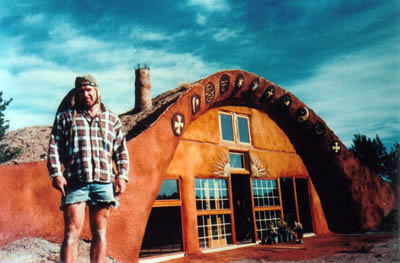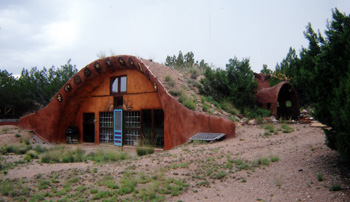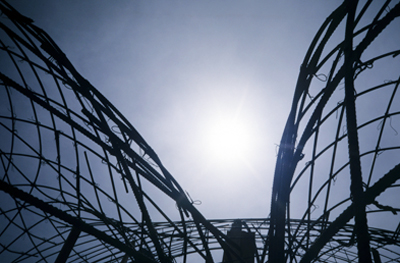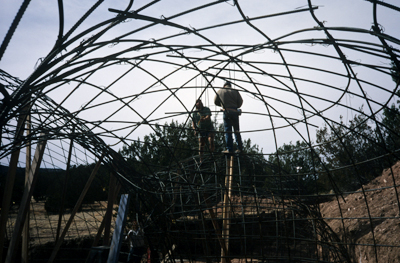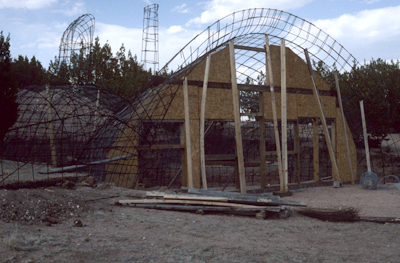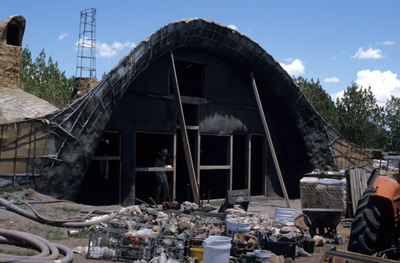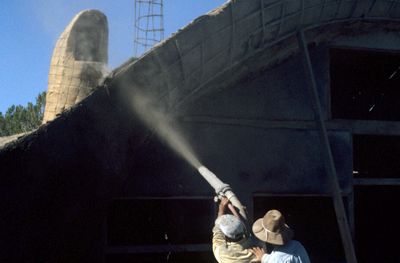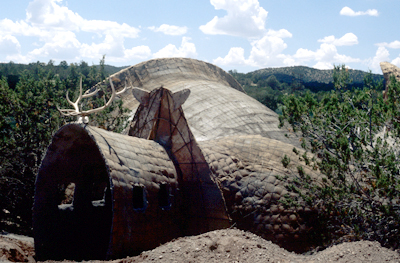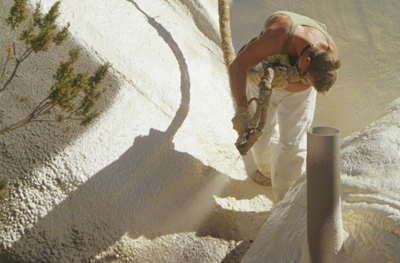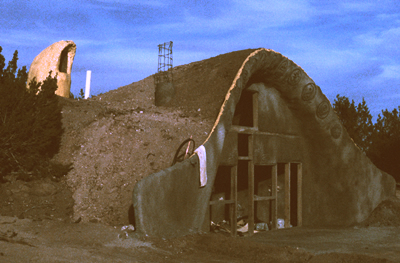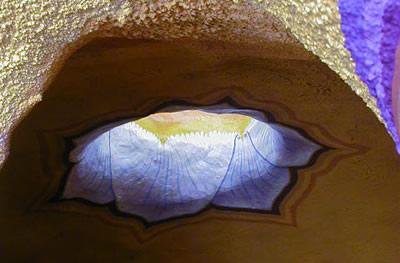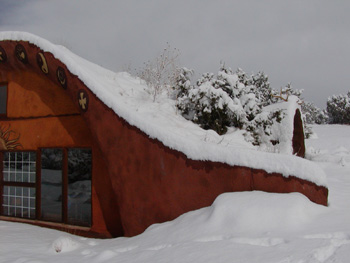Cody Lundin’s Self-Reliant Home...doing more with less.
Read an excerpt about Cody’s self-reliant home from his best-selling book When All Hell Breaks Loose: Stuff You Need to Survive When Disaster Strikes!
Chapter 12: Gimme Shelter!
“If design, production, and construction cannot be channeled to serve survival, if we fabricate an environment—of which, after all, we seem an inseparable part—but cannot make it an organically possible extension of ourselves, then the end of the race may well appear in sight.”
–
Richard Neutra, Survival Through Design
The optimum ambient temperature in which human beings are able to maintain core body temperature without stress is 79 to 86 degrees F (26 to 30 degrees C). Although the modern home now serves many purposes, physical and psychological, a home used to have one main priority. It matters not if your home is a mansion or a shack for this purpose. Both the mansion and the shack are simply shelters, and a shelter’s main purpose in the past was to act as an extension of clothing to help thermoregulate the core body temperature of its occupants. I don’t care how much money you’ve dumped into your shelter to compete with the Joneses, if it’s too hot or cold inside, you’ll be miserable. This almighty god called “room temperature” is a phenomenon so common and taken for granted that its importance to comfort and happiness has been completely overlooked by modern urbanites. It’s only when the invisible switch of room temperature clicks off that people realize how dependent on the grid they have become.
According to Tony Brown, founder and director of the Ecosa Institute, Americans use more than 30 percent of the country’s total energy budget to heat and cool their homes. This wasteful blasphemy should hammer home the point that stabilizing the inner temperature of the home ranks high on the list of priorities for all Americans. It’s a blasphemy because there are many alternative building and common-sense options for builders and homeowners alike that severely reduce or all but eliminate the need for heating and cooling the home with outside resources. The Ecosa Institute is a sustainable design school for architecture students that teaches alternative methods of design, construction, and energy efficiency. It is part of the growing tide of people worldwide who know there are better options for building smart, efficient homes without pillaging the land. Imagine how much freer this nation and the world would be if common-sense building alternatives to promote energy efficiency were actively promoted by the world’s governments. What if we eliminated even half of the above percentage of our nation’s energy dependence by simply building or modifying current homes to make better use of free energy sources and conserve the ones they use? Luckily, we don’t have to wait for status quo politicians who seem to be more interested in keeping their job than doing their job. top
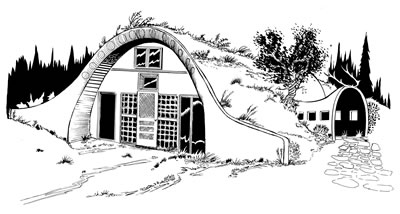
The Self-Reliant Freedom of Good Design
“My precept to all who build is, that the owner should be an ornament to the house, and not the house to the owner.” -- Cicero
In a modern outdoor survival situation the most common way to die is to succumb to hypothermia, low body temperature, or hyperthermia, high body temperature. Knowing this, and knowing that this country has become a slave to foreign energy in order to have a comfortable living room, I wanted to design a home that would thermoregulate its own core body temperature, and I have. While my home looks unconventional, the basic concepts that I’ve incorporated to achieve energy freedom are orientation, thermal mass, and insulation. These common-sense concepts can be applied to any home regardless of the materials it’s constructed from or how it looks.
It’s winter in the high desert as I write this, and last night the thermometer outside read 9 degrees F (minus 13 degrees C), a bit colder than typical and, ironically, part of the same storm system that left 500,000 people without power in the Midwest. Regardless of single-digit temperatures, my home remained a cozy 72 degrees F (22 degrees C), and it did so without using any conventional energy resources. I have no heating bills of any kind and I don’t burn wood. My home is heated entirely by the free clean energy of the sun, a phenomenon commonly referred to as “passive solar.” Along with orienting my home solar south, I have the proper square footage of windows to match the square footage of my home so that it doesn’t under- or overheat. These windows let in shortwave radiation from the sun that soaks into my stone floor during the day. At night when outside temperatures dip, the stone floor, which is a great conductor of the sun’s energy, re-radiates the stored sunshine, or heat, as long-wave radiation that keeps the house warm. Insulation and thermal mass help retain the heat throughout the night. The process starts anew the next day. Even though my home is dependent on the sun for heat, it’s designed to retain this comfort for several days of cloudy weather or storms. top
In the summertime, when outside temperatures hit triple digits, I enjoy inside temps in the high 70s (approximately 25 degrees C). I have no cooling bills of any kind. A simple roof overhang designed for my window height and latitude keeps the higher summer sun’s rays from hitting the stone floor. My windows and doors are situated to take advantage of the prevailing weather patterns and the cooler nighttime breezes. In fact, the entire front of the house is a huge parabola that acts as a scoop to harness the dominant southwestern weather systems for optimal natural free ventilation when required. Once again, thermal mass and insulation keep out hot temperatures while maintaining the cooler inside environment.
I’ve utilized an open floor plan that allows natural light from the sun to reach all rooms of the house, even though my house is underground. This eliminates the need for artificial lighting of any kind until it gets dark outside. The wall paint is impregnated with mica, which is highly reflective of natural or artificial light, thereby increasing the light value. Hundreds of pieces of shattered mirror line a vertical skylight that reflects sunlight into a back room that has no windows of its own.
What electrical lighting, appliances (including a microwave, washing machine, and computer), and tools that I require are powered by a self-contained solar system. A carport to shield vehicles from the summer sun doubles as a rain catchment surface, which funnels thousands of gallons of potable water into a holding tank that gravity feeds into the house. My hot water comes from the sun as well, which heats up water-filled panels and the salvaged inside of a conventional water heater that’s painted black. Although much of the time I use a small, two-burner, propane-fueled stove for cooking, my solar oven cooks everything from lentil soup to chocolate cake for free. Regardless of my frequent stove use, by paying attention to fuel consumption as outlined in the creative cooking chapter, I can make my barbeque grill-sized propane tank (twenty-pound cylinder) last more than a year and a half. And it costs less than thirteen dollars to fill. top
The rooms in my home are a series of parabolas, one of nature’s strongest shapes, thus my home was built for a fraction of the cost of traditional earth homes that require massive infrastructure to hold up the weight of the earth. The shape of my roof is, of course, arched, like the top of an igloo, so even though grass and flowers grow on the roof, it doesn’t leak, as there is no flat surface for water to collect. The precipitation that does hit the roof is directed by earthen contours and berms toward waiting fruit trees that are heavily mulched with compost, sand, and stone to conserve water. The earth acts as thermal mass, helping to slow down fluctuations in temperature, and the grasses on the roof not only stabilize the earth from erosion, but act as insulation, especially during the hot summer months when they shade the roof from the sun. The hot-season native gramma grasses require no water other than rain and also provide forage for the wild desert cottontail rabbits (which I hunt for food) that live on my roof.
In short, my off-the-grid home thermoregulates its own inner temperature in hot and cold weather extremes, self-ventilates, lights itself during daylight hours, and provides supplemental meat for the table, all for free, and all with very little activity on my part. It does so because I researched and implemented the virtues of good building design and paid strict attention to the natural world of my particular building site.
Check out Cody’s best-selling book When All Hell Breaks Loose

